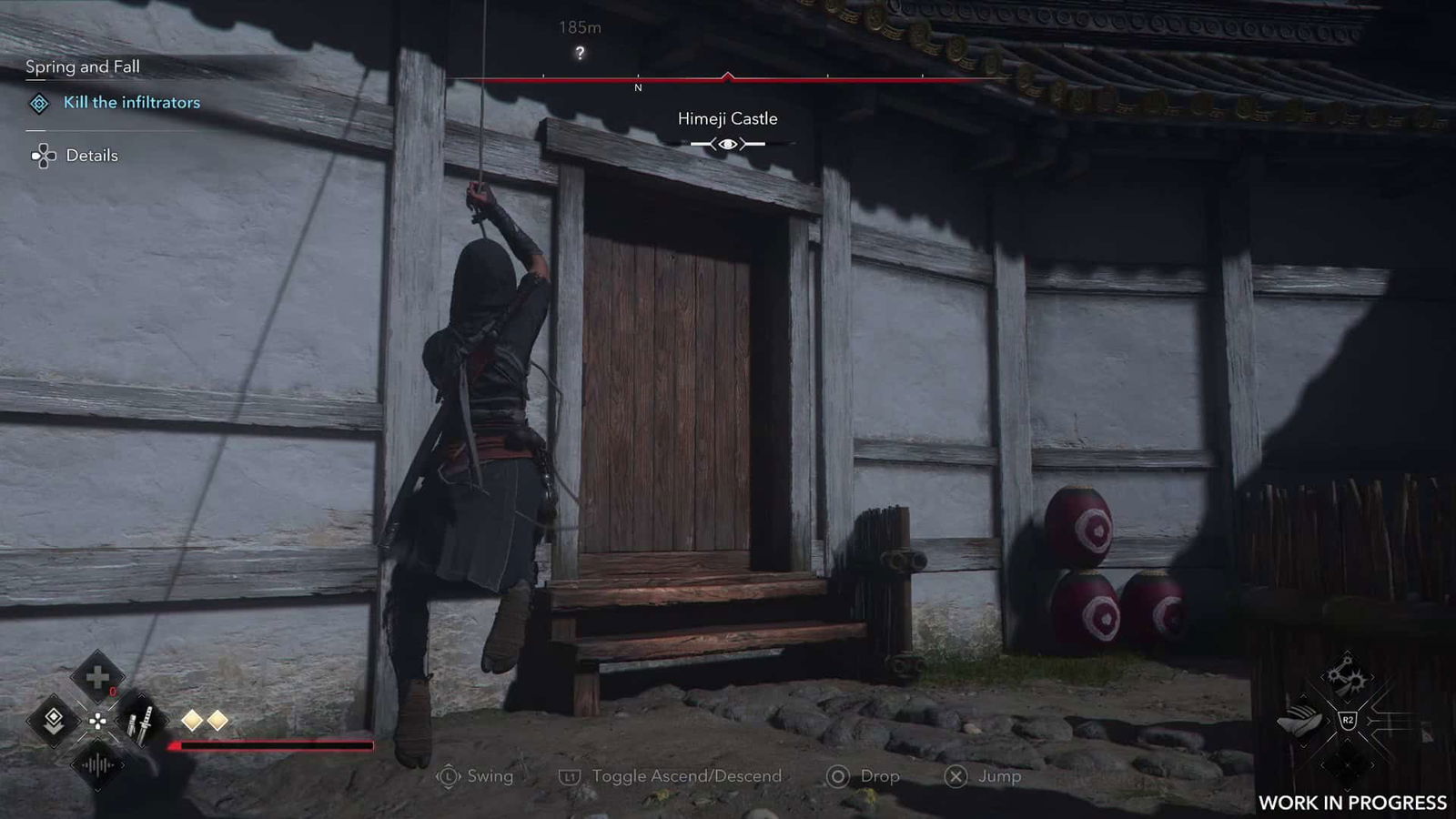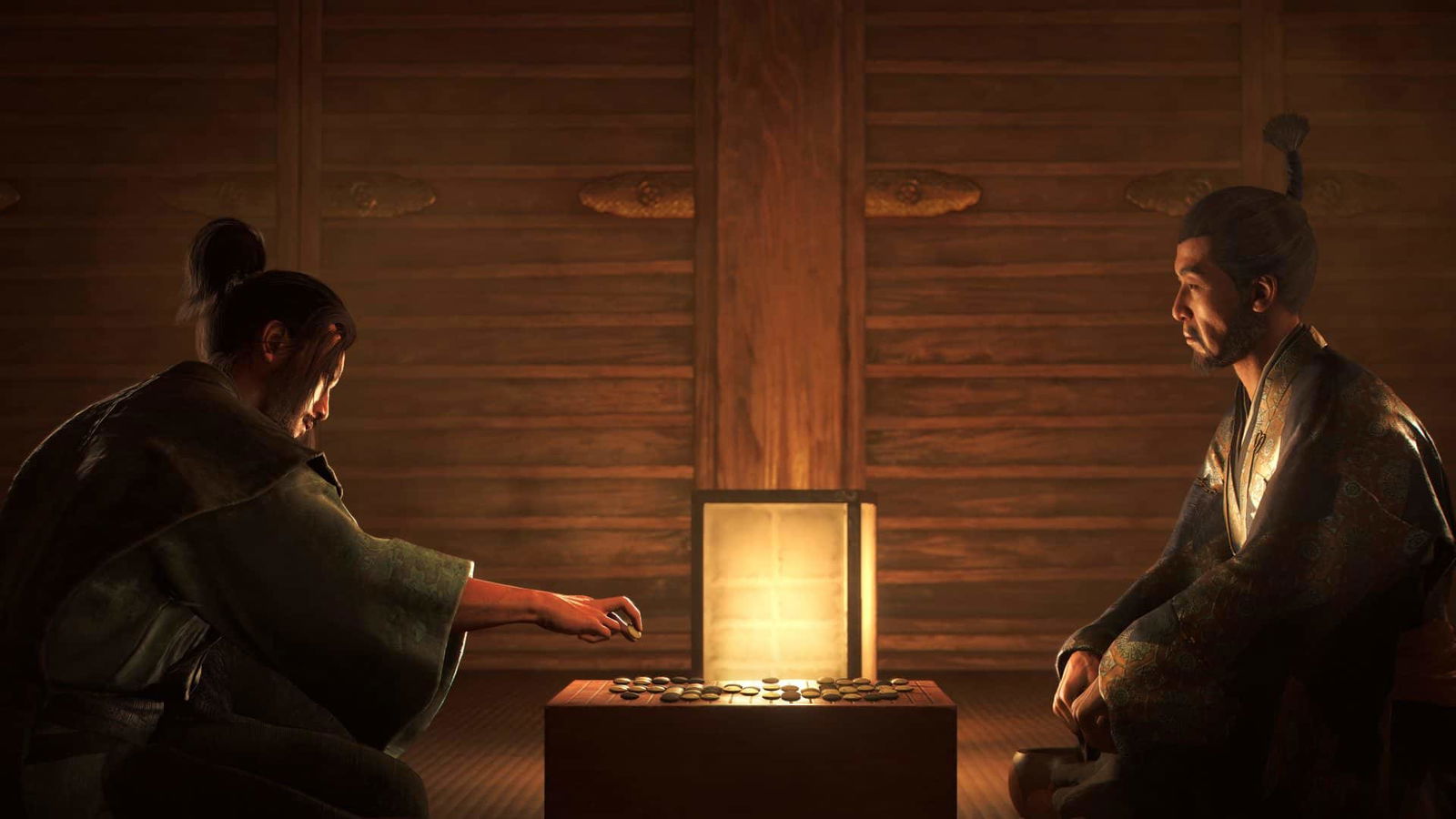Recently, thanks to Ubisoft, we had the chance to take part in an Assassin’s Creed Shadows hands-on preview, Scott and I were both invited to play the game for up to four hours, albeit remotely, which is worth keeping in mind.
So, what exactly did we have access to in this preview? Firstly, we did get to play the game’s prologue section; however, we are not able to discuss that today. Instead, we will focus on the part of our preview where we jumped several hours into the game. At this time, we were given one region of the open world to explore and a main quest to complete.
Choosing Between Yasuke and Naoe: The Assassin vs Samurai Dynamic
I personally spent the majority of my time playing as the shinobi Naoe, with Scott more focused on Yasuke in his preview session. It’s safe to say our experiences were very different. As Naoe, I found traversal much easier and focused on stealth, avoiding combat where possible. Naoe is fast and agile, both in combat and when traversing the world, whether on horseback or through parkour. These attributes make Naoe feel like the first true assassin we’ve had in the franchise for quite some time. She is stealth-focused but capable in combat when required, though when playing as Naoe, you can be easily overrun by more than one or two enemies. Fans of the older titles especially will enjoy playing as Naoe.
Yasuke, on the other hand, is slower in traversal and less capable in parkour, but he does have some big advantages, as Scott knows well.
Yasuke is, in every sense of the word, a tank. He can take a lot of damage and still keep moving. I was able to use a variety of weapons, like bows, clubs, muskets, and katanas, when it came to his movesets. I primarily used his katana and his musket. With the katana, you can parry enemy attacks and perform powerful swings that strike enemies. The musket is a single shot but can be reloaded if you are far enough away that you won’t be hit by anyone. He is slower and can’t really take full advantage of parkour. He doesn’t even have access to the grappling hook; instead, he gets through his encounters by literally barrelling himself at the doors of castles and houses. He can break doors if he sprints at them. The downside is that everybody knows he is there once inside. When you are using Yasuke, your focus is on combat and dealing with a ton of enemies at once.
An Experience Led By You
With our experience in the Harima region, we got to play through a main story questline. We were in an area of the game where it recommended your characters be level 25. The Assassin’s Creed Shadows gameplay loop we experienced seemed indicative of this level and, hopefully, reflects the rest of the game. Main quests appear to involve meeting someone who gives Yasuke and Naoe a task, and you have the option of how to tackle these tasks. These options are generally completed simultaneously by both main characters. The dialogue even suggests that they are sometimes fulfilling different roles in the service of the quest, leaving you to choose who you want to play as.
If you choose Yasuke, you’re usually barrelling your way through a castle or a location to talk to someone. If you choose Naoe, you’ll sneak inside to gather information, either avoiding detection or killing enemies from the rooftops. During a quest, you may even have the option to switch roles partway through, typically after a cutscene. Once the mission is complete, you’ll be instructed to report back on the quest, and the other main character will already be there, having finished their role.
Outside of the main quests, the world is filled with side quests and activities, marked near you by question marks that you can follow to earn additional items and experience. Thankfully, these seem to be more sparingly used than in Assassin’s Creed Valhalla. Having two playable characters means some side quests require you to play as a specific character to engage with them. However, you can easily switch characters by going to the menu and holding a certain button, so swapping isn’t a big hassle.
The Noble Questline: What’s New in Assassin’s Creed Shadows
The quest we played was known as the Noble questline, which takes place in the region of Harima. You are tasked with meeting Kuroda Kanbei at Himeji Castle. Kanbei is concerned about a hidden threat, so he asks Yasuke and Naoe to investigate their connections in the shadows to uncover anyone who might be planning an attack on the castle without his knowledge. His concern stems from the fact that all of Hideyoshi’s allies will be gathering at the castle the following day, and he wants to ensure they don’t lose them all in a single attack.
The night before the gathering, Naoe encounters Ukita Naoie as he prepares a stanza. The castle is suddenly attacked by Ronin, but Yasuke and Naoe fend them off, only to discover that Ukita Naoie’s son has been kidnapped by the attackers. The two set out to gather leads, eventually tracking down Ukita’s son. Throughout this questline, themes of regret and guilt are explored. The story culminates in several surprising twists that lead up to a massive assault on the castle the next night, where Naoe and Yasuke must protect Kuroda Kanbei from invading forces.
One aspect we greatly enjoyed was the freedom to choose how to extract information. You can either use force and intimidate people to choke information out of them, or rely on a silver tongue, selecting different dialogue options to persuade them.
Deeper Combat and Traversal Mechanics
During our time with Assassin’s Creed Shadows, a few things truly stood out. Firstly, parkour has seen significant improvements, making it more engaging than ever. It’s no longer a simple “hold-one-button-and-push-forward” system. Now, you need to actively search for handholds and climbable surfaces, reminiscent of the early days of the franchise. Additionally, parkouring down has made a return and can now be combined with dodging, allowing for even quicker traversal. While it may not be as free-flowing as Assassin’s Creed: Unity, Shadows provides more options for parkour than we’ve seen in years, resulting in a much more dynamic system. This is further enhanced by the fact that your parkouring capabilities vary depending on which character you’re playing.
Combat also appears to have received major improvements, drawing inspiration from the recent RPG-focused Assassin’s Creed titles. You have access to both light and heavy attacks, and holding either button lets you charge a posture attack. These charged moves are great for breaking an enemy’s defenses or armor, but missing them can leave you vulnerable. Perfectly timed parries put enemies in a weakened state, indicated by a yellow glow, allowing you to deal massive damage for a brief period. Finishing off enemies in this state triggers a brutal finishing move, adding an extra layer of satisfaction to combat.
Fans of recent entries like Valhalla or Odyssey will be pleased to hear that special attacks and skills, activated by building momentum, are back—and possibly in greater numbers. While we can’t confirm the exact quantity, each weapon appears to have its own unique activatable abilities, and both characters also seem to possess distinct skills. Yasuke’s Spartan kick, for example, has quickly become one of our favorites!
As with parkour, Naoe and Yasuke have distinct combat styles. Naoe excels in one-on-one engagements, with her ability to deflect enemy attacks and quickly get behind foes, making her ideal for duels. However, she can be easily overwhelmed by groups of enemies. Yasuke, on the other hand, is a powerhouse, capable of taking on multiple enemies with ease. His size and strength allow him to partially block the damage of otherwise unblockable attacks, giving him a distinct advantage in crowd control. These differences ensure that you’ll need to adapt your strategy depending on the character you’re using. Adding to the challenge, the AI is smart enough to capitalize on any mistakes you make.
Technical Impressions and Performance
Assassin’s Creed Shadows has been delayed a number of times, and this is where you get to see the reason why. There are many moving parts in Assassin’s Creed Shadows, including dynamic shadows, enemy AI, a weather and season system, and numerous ways to approach the game. During our preview, Scott encountered a few hiccups in cutscenes where shadows and lighting occasionally stuttered, and both of us experienced some framerate drops. However, it’s worth noting that this preview was fully remote—we played on controllers while connected to someone else’s machine on a work-in-progress build of the game. These issues are unlikely to reflect the final release.
In truth, this was one of the more polished preview builds we’ve had the chance to play, which gives us high hopes for the finished product.
Immersion Mode vs Canon Mode: Which is Best?
We played the game in Immersion Mode. At the start of a new game, you are given two choices: play in Canon Mode, which removes your agency in cutscenes, or play in Immersion Mode. Immersion Mode ensures that all characters speak their native languages—the Japanese speak Japanese, the Spanish speak Spanish, and so on. Essentially, it’s your choice between subbed or dubbed audio.
We opted for Immersion Mode to test its authenticity, and honestly, it was incredibly enjoyable. Names were pronounced accurately in their respective languages, and the emotional delivery aligned perfectly with what you’d expect from a live-action Japanese movie. While some might have preferred more animated performances akin to an anime, we felt the grounded and natural Japanese dub was the better choice.
Finding Balance Between Old and New
Scott and I share a long history with the Assassin’s Creed franchise, starting with the original game on the Xbox 360 and PS3. We’ve played most of the series since then, though we both dropped off Valhalla fairly quickly due to its sheer size and scope. While Scott hasn’t yet played Mirage—which I have played and thoroughly enjoyed—he’s played up to Odyssey. Some of our favorite entries in the series remain the Ezio trilogy: Assassin’s Creed II, Brotherhood, and Revelations.
Scott shared his thoughts, saying, “I really loved sneaking, stealth, and parkour. The best moments of the early Assassin’s Creed games, to me, were the spectacle of the locations. The cathedrals in II were unmatched in how awesome it felt to jump across them and discover different ways to scale the big buildings.” I couldn’t agree more.
Combat wasn’t bad, but the emphasis on stealth—hiding and finding the right opportunities—made the experience far more rewarding. Stealth didn’t feel like a chore; instead, it was engaging and satisfying. Unfortunately, many modern games still struggle to make stealth fun, and even some of the later Assassin’s Creed titles suffered from this, with odd enemy AI making the mechanics feel clunky. For me, Brotherhood and II struck the perfect balance between stealth and action.
As the series evolved, later games shifted their focus more heavily toward combat, often increasing difficulty by simply throwing more enemies at the player. This pivot, especially in the RPG-inspired entries, left some fans feeling like the franchise had drifted from its core identity of being about assassins.
Thankfully, Assassin’s Creed: Shadows feels like a step in the right direction. With its improvements to parkour and stealth, I felt more like an assassin than I have in years. Striking the perfect balance between old-school stealth Assassin’s Creed Shadows gameplay and modern mechanics to please a diverse audience will always be a challenge, but Shadows seems closer to achieving it than any game in recent memory.
If the rest of the experience holds up to the standard we’ve seen so far, we’re in for a real treat.
Assassin’s Creed Shadows will be released for Xbox Series X/S, PS5, and PC on March 20th, 2025.






